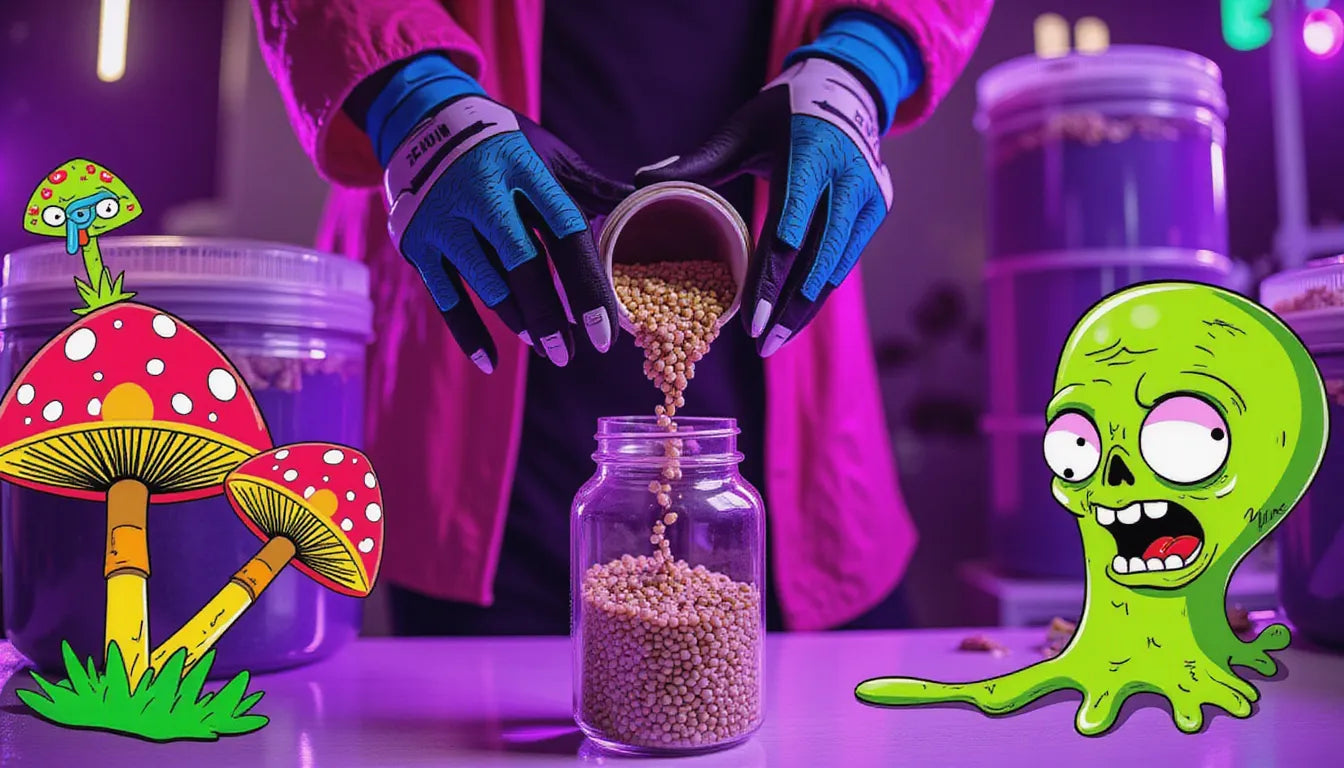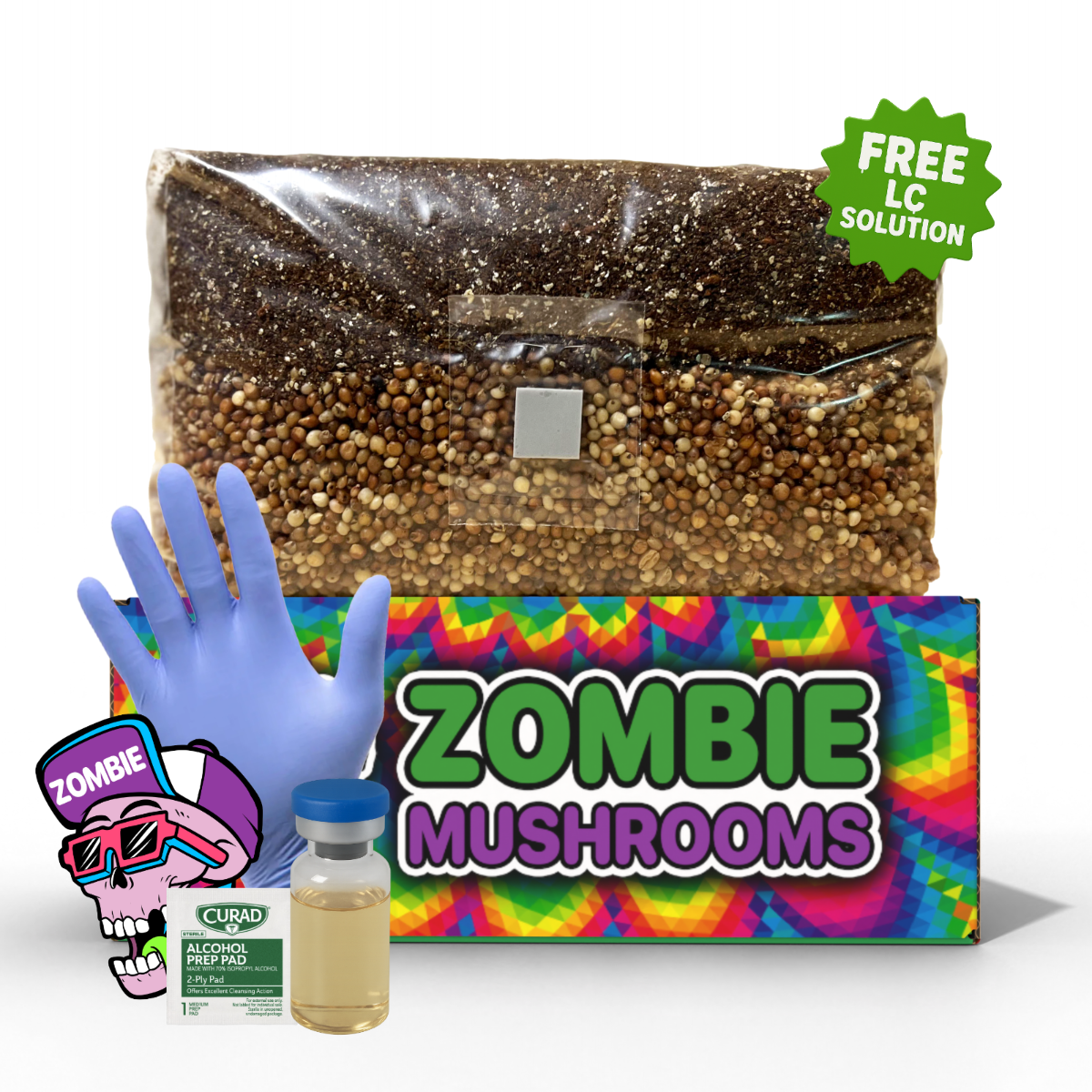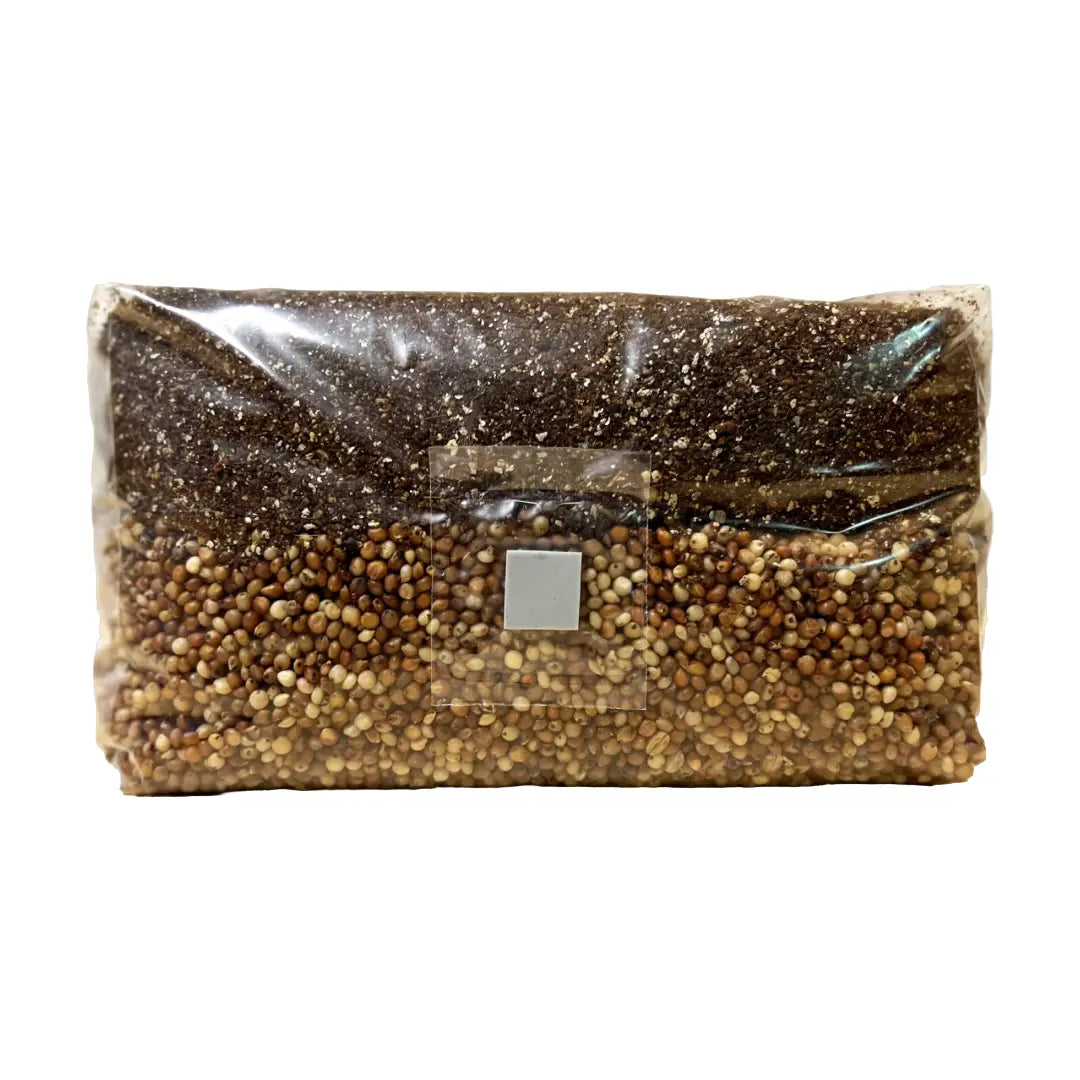⬇️ Prefer to listen instead? ⬇️

- 🧫 WBS (wild bird seed) has balanced nutrients that are good for early mycelium growth.
- 💰 Growers can save up to 50% on grain spawn costs when using wild bird seed instead of rye.
- ⚠️ More than 60% of contamination happens because seeds are not prepared or dried correctly.
- 🌾 Bird seed mixes with lots of millet work better for growing mushrooms like lion's mane.
- 🔬 Studies show that different substrate particle sizes affect how mycelium spreads.
Mushroom growers know that good spawn is key to growing mushrooms. Grain spawn is a nutrient-rich base where mushroom mycelium starts to grow. Using the right grain matters a lot. Many growers use traditional grains like rye, millet, and wheat berries. But some are now trying wild bird seed (WBS) because it is easier to get and cheaper. Is bird seed a good choice for growing mushrooms? Let's find out. To make experimenting with different grains even easier, our mushroom grow bags provide a clean, ready-to-use environment that supports strong mycelium growth and healthy flushes.

1. What Is Wild Bird Seed (WBS)?
Wild bird seed (WBS) is a common grain mix. Stores sell it as food for outdoor birds. It is made for birds. But it has many kinds of grains and seeds, so it can be useful for mushroom growers. The most common parts include:
- White and Red Millet: High in carbohydrates and easy for mycelium to grow on.
- Cracked Corn: Adds bulk but can raise the risk of contamination.
- Milo (Sorghum): Has nutrients but grows slowly if not wet enough.
- Sunflower Seeds: High fat content, can spoil after sterilization.
When growing mushrooms, the main thing is if the seed mix helps mycelium grow well and does not have bad additives. Plain, untreated seeds work best. Mixes with oil or coatings can slow down growth and cause bacteria problems.
Watch For These Red Flags
When picking WBS for grain spawn, do not choose mixes that:
- Have black oil sunflower seeds.
- Have a lot of cracked corn.
- Say they have added vitamins or preservatives.
- Say terms like "fortified," "coated," or “enhanced.”
These additives are for birds. But they can have anti-fungal stuff or sugars that cause mold instead of mycelium. Always pick mixes without chemical coatings or dyes.
2. Why Use Wild Bird Seed for Grain Spawn?
WBS has good points for both new and experienced growers. Here is why many use it:
✔️ Broad Availability
You can find WBS in big stores, pet stores, and dollar stores. It is easy to get. So, it is a simple starting point if a project goes bad or you need to try something new fast.
💡 Cost-Effectiveness
Seed mixes often cost 30% to 60% less than special grains. If you grow as a hobby and use many jars or bags, you save money fast. This is true when rye berries or millet are expensive or you have to buy them online in bulk.
🔬 Nutritional Profile
Wild bird seed mixes have a balanced mix of:
- Carbohydrates for energy.
- Proteins for enzyme work.
- Trace minerals help enzymes work well and make fungi strong.
It is not perfect like lab-made bases. But WBS prepared well can grow mycelium strong and produce crops as good as expensive spawn.
🧪 Suitable for Diverse Fungi
WBS works for many mushroom types. This includes oyster mushrooms, which are easy for new growers, and gourmet types like lion's mane. Millet-rich mixes work best. Just make sure to sterilize them right and use good seed amounts.

3. Selecting the Right Bird Seed Mix
Not all WBS products work the same. The details matter. A good mix depends on its ingredients. Look for a mix that has a lot of millet. It should have little to no sunflower seeds or cracked corn.
Ideal Grain Ratios
| Seed Type | Recommended Inclusion | Notes |
|---|---|---|
| White Millet | 50–70% | Easy for mycelium to grow on and to get wet |
| Red Millet | 10–30% | Grows slower but has many carbs |
| Milo (Sorghum) | Optional (≤20%) | Adds variety, must get wet enough |
| Cracked Corn | <10% | Risk of contamination, do not use a lot |
| Sunflower Seed | 0% | Gets rancid after sterilization |
Brands made for wild birds, not pet birds, usually have fewer unnatural things added. Choose clear bags. If you can, check ingredients online or ask suppliers about additives and how the seeds are treated.

4. How to Prepare Wild Bird Seed for Grain Spawn Using Spawn Substrate Properly
Before using WBS in your mushroom grain spawn jars or grain substrate mix, follow this “how to use”-oriented preparation to minimize contamination and improve mycelium jars success:
Step 1: Rinse WBS thoroughly
Use a fine mesh strainer or colander. Running cold water removes dust, broken seeds, and residual pesticides. Clean bird seed is essential for sterile bird seed spawn jars.
Step 2: Soak for 12–24 hours
Use a ratio of 1 part seed to 4 parts water. Optional: add 1 Tbsp gypsum to the soak to buffer minerals. This soak softens outer layers of the grain for better water absorption in spawn substrate.
Step 3: Simmer for 30–45 minutes
Gently cook until the interior of seed is moist but not bursting. This “no-soak, no-simmer millet tek” style isn’t ideal for WBS because seed diversity requires more prep.
Step 4: Drain and surface-dry
Spread seeds onto clean towels or drying screens. Seed should be dry on the outside but hold moisture inside. If it feels sticky or overly wet, allow more drying time.
Step 5: Fill grain jars or spawn bags and sterilize
Fill mushroom spawn jars or bags about two-thirds full. Use lids with filters (SHIPs or synthetic). Sterilize in a pressure cooker at 15 PSI for 90-120 minutes depending on volume. Proper sterilization helps prevent grain jar contamination.
Tip: Hold some seeds in your hand and shake them. If your palm gets wet or sticky, they are not ready.
Do not skip steps. You must pressure sterilize. Steaming or boiling is not enough. It makes contamination much more likely.

5. Sterilization Process and Contamination Prevention
Being cheap comes with a downside: more risk of contamination. Bird seed has different size and weight seeds. If you do not sterilize it right, bacteria will grow easily.
Major Contaminant Types
| Contaminant | Appearance | Cause |
|---|---|---|
| Wet Spot (Bacteria) | Sour smell, slimy seeds | Too much water, not enough sterilization |
| Trichoderma (Green Mold) | Bright green fuzz | Spores got in during handling |
| Cobweb Mold | Grey, wispy growth | Not clean enough procedures |
Cleanroom Practices
- Work near a still-air box (SAB) or a laminar flow hood.
- Wear new gloves.
- Spray all tools and surfaces with alcohol.
- Only use clean cultures to inoculate. Never use jars that look bad.

6. How to Use Spawn Substrate: Inoculating Grain Jars with Liquid Culture or Agar
Once your WBS grain jars for mushrooms are sterilized and cooled, here’s how to inoculate effectively to reduce colonization time and improve yields:
- Inoculate using liquid culture: Using healthy LC (liquid culture) often leads to faster colonization than spore syringe, as living mycelium is already active. Adds consistency across your spawn substrate.
- Alternatively use agar wedges: If precision matters, agar offers pure genetic transfer. Sterilization and clean tools (flame-sterilized scalpel or loop) are crucial to avoid contamination.
- Shake at early stages: After inoculation, gently shake the grain jar or bag to distribute the inoculant evenly. Shake again when around 25-30% of the jar is colonized to speed up the process.
- Monitor colonization time: WBS grain spawn usually completes colonization in 10-21 days, depending on species, temperature, and how clean your substrate is. Some mushrooms like oyster or lion’s mane on millet mixes may finish toward the lower end of that range.
Shaking and Colonization Tips
- Shake when you first add the inoculant to spread it around.
- Shake again when about 30% of the grain is covered. This helps it grow faster.
- Growth usually finishes in 10 to 21 days.

7. Pros of Using WBS for Spawn Production
Here is why WBS is a good choice:
- 🚀 Saves Money: It cuts spawn prep costs but still works well.
- 🧪 Good Nutrition: The seed mix has many micro-nutrients. These make the mycelium strong.
- 🛍 Easy to Find: You do not need to order it online from special stores. You can buy it in stores easily.
- 🧉 Works with Liquid Culture: Seeds soak up liquid well, so it works very well with LC.

8. Cons and Challenges of WBS Grain Spawn
WBS works, but you need to be extra careful and get it just right:
- ⚖ Not Always the Same: Brand A and B can be very different in what they contain.
- 🌡️ Hard to Dry: Millet, milo, and corn soak up water in different ways. This makes drying harder.
- 🌻 Sunflower Seeds: Their high fat content slows growth and can cause bacteria problems.
- 🔩 Needs More Prep: It needs more cleaning, soaking, and checking than single-grain spawn.

9. Comparison: Bird Seed vs Traditional Grain Spawn Options
Here is a comparison to help you choose:
| Grain Type | Cost | Nutrient Density | Prep Difficulty | Contamination Risk | Availability |
|---|---|---|---|---|---|
| Wild Bird Seed | ★★★★★ | ★★★★☆ | ★★★☆☆ | ★★☆☆☆ | ★★★★★ |
| Rye Berries | ★★☆☆☆ | ★★★★★ | ★★☆☆☆ | ★★☆☆☆ | ★★☆☆☆ |
| Millet | ★★★★☆ | ★★★★☆ | ★★☆☆☆ | ★☆☆☆☆ | ★★★★☆ |
| Wheat Berries | ★★★☆☆ | ★★★★☆ | ★★☆☆☆ | ★★☆☆☆ | ★★★☆☆ |

10. Mushrooms That Perform Well with WBS Spawn Substrate
WBS is useful for a variety of edible and gourmet mushrooms. If you’re using grain spawn tek, here are species that thrive well in grain jars mushrooms with wild bird seed-based spawn substrate:
- Oyster Mushrooms (Pleurotus spp.) — fast colonizers, good yields using WBS grain jars.
- Lion’s Mane (Hericium erinaceus) — especially responsive when the WBS mix has plenty of millet.
- Shiitake (Lentinula edodes) — tolerates WBS spawn but may prefer woodier or supplemented substrate over time.
- Reishi (Ganoderma lucidum) — works, but strict sterilization needed to avoid issues, especially with fatty seed content.
11. Buying Tips — Where to Source Quality Bird Seed
You can find good sources at:
- Big-box stores: Walmart, Tractor Supply, Home Depot.
- Online stores: Amazon, Chewy, special pet stores.
- Co-ops and feed stores: These often sell big bags with little extra stuff.
Suggested brands: Wagner’s Wild Bird Food (select millet-heavy versions), Valley Splendor, Audubon Park Natural Mix.
Tip: Shake the bag. If there is dust, the seeds are old or processed. Do not use them.

12. Troubleshooting: Common Pitfalls and Fixes
| Problem | Solution |
|---|---|
| Grains too wet after simmering | Drain longer; stir-dry on mesh or towel |
| Stalled colonization | Recheck sterilization; verify LC/agar quality |
| Visible mold or sour smell | Discard, sanitize workspace, retry batch |
| Uneven mycelial growth | Shake at 25–30% colonization to redistribute |
13. Frequently Asked Questions
-
How to sterilize bird seed for grain spawn?
To sterilize bird seed (WBS), soak, simmer, drain and surface dry, fill into jars or bags about two-thirds full, then pressure cook at 15 PSI for 90-120 minutes. Using lids with filters (SHIPs or synthetic) helps maintain sterility during and after the process. -
What’s the best grain for mycelium using wild bird seed?
Bird seed mixes heavy in millet (50-70%) give the best balance between moisture uptake and nutrient profile. Reduce sunflower, cracked corn, and additives to decrease contamination risk and improve spawn substrate performance. -
How long does it take for WBS grain spawn to colonize?
Wild bird seed grain spawn typically colonizes in 10-21 days, depending on species, cleanliness, inoculation method (liquid culture or agar vs spore), and conditions like temperature and moisture. -
What causes grain jar contamination when using bird seed?
The most common culprits are seed mixes with oils or coatings, insufficient rinsing and drying, inadequate sterilization, and poor cleanroom or inoculation hygiene. Using sterilization times recommended above and clean techniques helps avoid this. -
How to make mushroom spawn jars using WBS?
Fill sterilized jars with properly prepared WBS spawn substrate, inoculate with your culture or spores, shake when about 25-30% colonized, and maintain clean conditions. The jars should be filled no more than two-thirds to allow space, and lids should have filters.
14. Is It Worth It? Final Verdict on WBS Spawn
Wild bird seed has some small downsides. But it is still a smart choice if you grow mushrooms yourself. It is cheap, easy to get, and works for many things if you sterilize it carefully. Growers who know more might like how cheap it is and how well it works for different mushroom types.
If you are new to growing edible mushrooms and want to save money, WBS grain spawn is a great choice.
15. Zombie Mushrooms Tip: Pre-Sterilized Premium Spawn Bags
Want to skip preparing grain? Our spawn bags are ready to use. They come already sterilized with top grains. This gives you fast mycelium growth and a start without contamination. They are perfect for home growers who do not have pressure cookers or want an easy time.
16. See Our Amazon Storefront
We made it easy to find good bird seed mixes, pressure cookers, micron filter bags, and mushroom grow kits. They are all in one place. Go to our Zombie Mushrooms Storefront. There you will find hand-picked tools and trusted products to help your growing efforts.
Citations:
Stamets, P. (2000). Growing gourmet and medicinal mushrooms. Berkeley, CA: Ten Speed Press.
Oei, P. (2005). Small-scale mushroom cultivation: Oyster, shiitake and wood ear mushrooms. FAO.
Stamets, P., & Chilton, J. S. (1983). The Mushroom Cultivator: A Practical Guide to Growing Mushrooms at Home. Olympia, WA: Agarikon Press.




